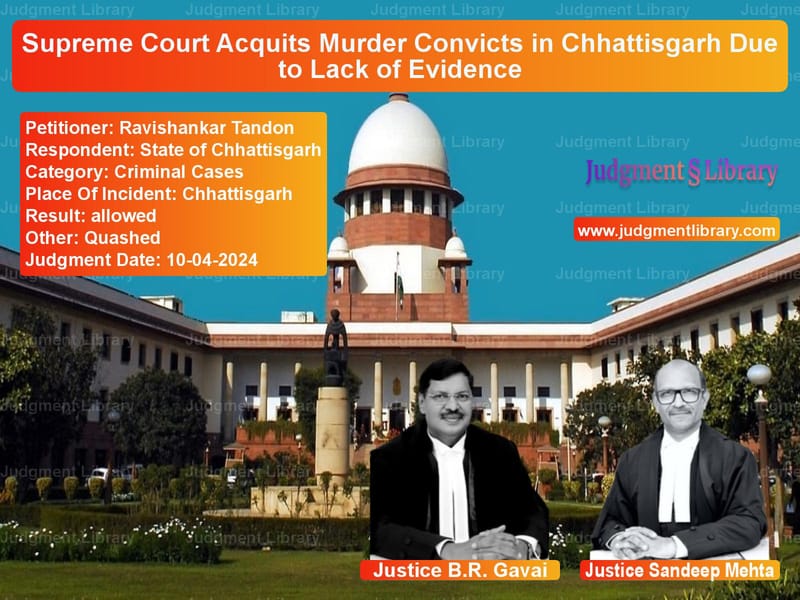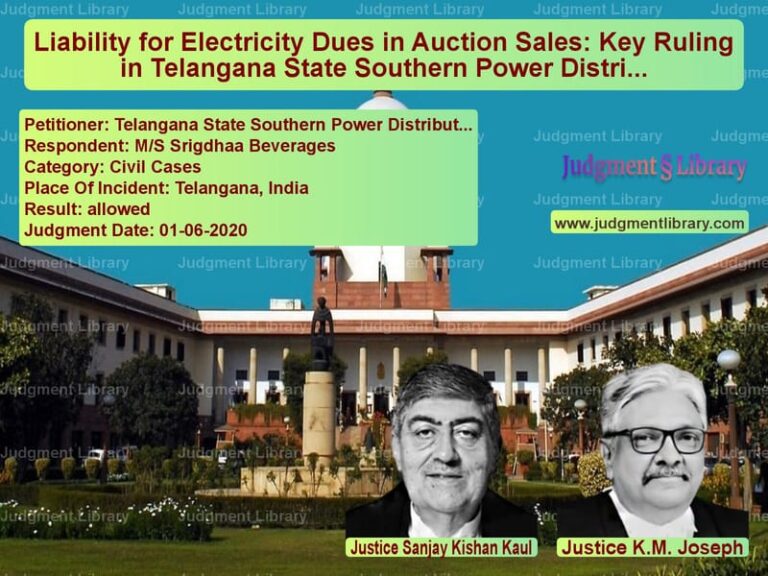Supreme Court Acquits Murder Convicts in Chhattisgarh Due to Lack of Evidence
The case of Ravishankar Tandon vs. State of Chhattisgarh is a significant judgment where the Supreme Court overturned the convictions of four individuals accused of murder due to lack of concrete evidence. The case was primarily based on circumstantial evidence, and the prosecution failed to establish a direct link between the accused and the crime. The ruling reinforced the principle that suspicion, no matter how strong, cannot replace proof beyond a reasonable doubt in criminal cases.
Background of the Case
The case stemmed from the disappearance of one Dharmendra Satnami on November 30, 2011. His father, Ramavtar (PW-1), lodged a missing person report at Police Station Kunda on December 2, 2011. The police interrogated the four accused—Ravishankar Tandon, Umend Prasad Dhritlahre, Dinesh Chandrakar, and Satyendra Kumar Patre—who allegedly confessed to strangulating the deceased and disposing of his body in a pond at Bhatgaon.
Based on these statements, the police recovered the deceased’s body on December 3, 2011. A post-mortem confirmed that the cause of death was asphyxia due to strangulation, classifying it as a homicidal death.
Key Legal Issues
- Whether the prosecution established the guilt of the accused beyond a reasonable doubt.
- Whether the alleged confessions under Section 27 of the Indian Evidence Act were admissible.
- Whether circumstantial evidence sufficiently proved the accused’s involvement.
- Whether procedural lapses affected the credibility of the prosecution’s case.
Arguments by the Appellants
The defense argued that the case was based entirely on circumstantial evidence, and the prosecution failed to prove a direct link between the accused and the murder. The defense submitted:
“The prosecution has failed to prove any incriminating circumstances beyond reasonable doubt. The chain of circumstances does not exclusively lead to the guilt of the accused.”
They also contended that the alleged confessions recorded under Section 27 of the Indian Evidence Act were unreliable and that police coercion could not be ruled out.
Arguments by the Respondent
The prosecution, represented by the State of Chhattisgarh, countered that the accused had confessed to the crime, and their statements had led to the discovery of the dead body. The State argued:
“The prosecution has proven its case beyond a reasonable doubt. The accused’s own statements led to the recovery of the body, which corroborates their involvement in the crime.”
The State further contended that the High Court and trial court had correctly appreciated the evidence and that no interference was warranted.
Supreme Court’s Analysis
1. Admissibility of Confessions Under Section 27
The Supreme Court examined whether the alleged confessions were legally admissible. The Court ruled:
“The prosecution must establish that the discovery of the dead body was based solely on the information provided by the accused. However, evidence suggests that the police and witnesses already knew about the body’s location before the accused made their statements.”
The Court noted inconsistencies in witness testimonies and procedural lapses in recording the accused’s statements, making them unreliable.
2. Circumstantial Evidence and Burden of Proof
Reiterating established legal principles, the Court held:
“In cases based on circumstantial evidence, the prosecution must establish a chain of events that leads to no other conclusion than the guilt of the accused. In this case, the prosecution failed to provide conclusive evidence linking the accused to the crime.”
The Court emphasized that suspicion, no matter how strong, cannot substitute for concrete proof.
3. Violation of Legal Safeguards
The Court also criticized the prosecution for procedural lapses, including irregularities in recording statements and failing to establish an independent chain of custody for the body’s recovery. It ruled:
“When procedural safeguards are ignored, the reliability of evidence becomes questionable. The benefit of doubt must go to the accused.”
Final Judgment
The Supreme Court overturned the High Court’s decision and set aside the conviction, ruling:
“The prosecution has utterly failed to prove the case beyond a reasonable doubt. The accused must be acquitted.”
The Court ordered the immediate release of the appellants unless they were required in any other case.
Key Takeaways from the Judgment
- Confessions made in police custody must be scrutinized carefully and corroborated by independent evidence.
- Circumstantial evidence must establish an unbroken chain of events leading exclusively to the guilt of the accused.
- Failure to adhere to procedural safeguards can weaken the prosecution’s case.
- Suspicion alone cannot justify a conviction; the prosecution must prove the case beyond reasonable doubt.
Judgment Date: April 10, 2024
Judges: B.R. Gavai, Sandeep Mehta
Petitioner Name: Ravishankar Tandon.Respondent Name: State of Chhattisgarh.Judgment By: Justice B.R. Gavai, Justice Sandeep Mehta.Place Of Incident: Chhattisgarh.Judgment Date: 10-04-2024.
Don’t miss out on the full details! Download the complete judgment in PDF format below and gain valuable insights instantly!
Download Judgment: ravishankar-tandon-vs-state-of-chhattisgar-supreme-court-of-india-judgment-dated-10-04-2024.pdf
Directly Download Judgment: Directly download this Judgment
See all petitions in Murder Cases
See all petitions in Bail and Anticipatory Bail
See all petitions in Custodial Deaths and Police Misconduct
See all petitions in Judgment by B R Gavai
See all petitions in Judgment by Sandeep Mehta
See all petitions in allowed
See all petitions in Quashed
See all petitions in supreme court of India judgments April 2024
See all petitions in 2024 judgments
See all posts in Criminal Cases Category
See all allowed petitions in Criminal Cases Category
See all Dismissed petitions in Criminal Cases Category
See all partially allowed petitions in Criminal Cases Category







